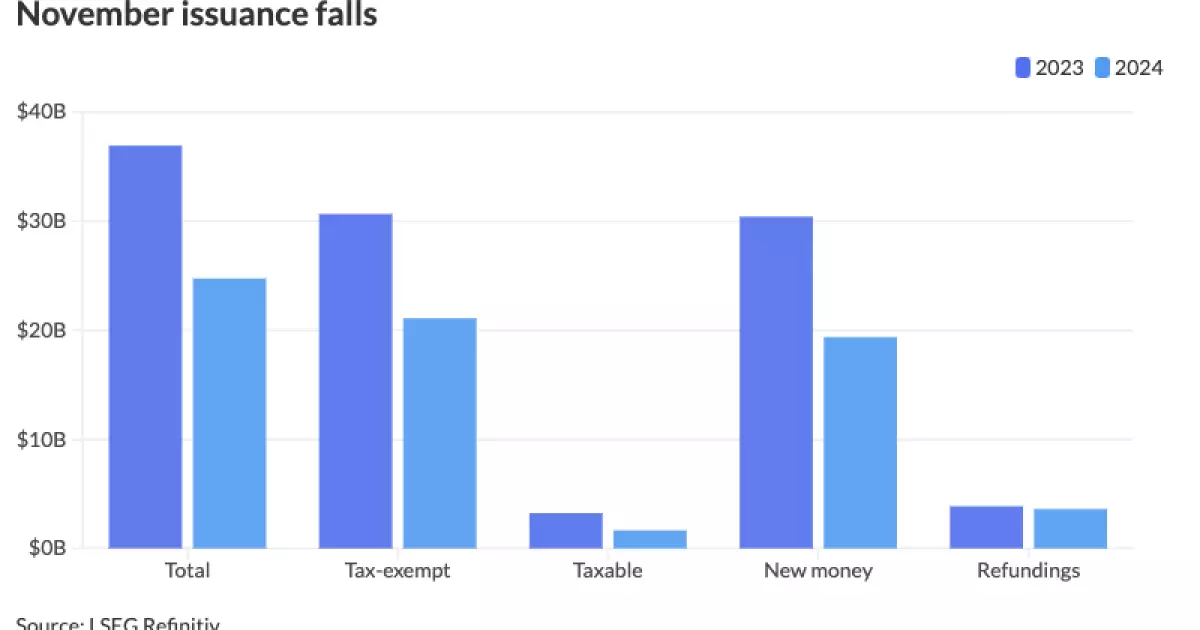The municipal bond market has been under scrutiny as it faced a significant year-over-year decline in issuance as of November 2024. This decline marks a noteworthy moment, as it represents the first decrease in supply within the year, primarily influenced by uncertain election outcomes and a limited number of available pricing days. Although November’s figures were stark, the overall outlook for bond issuance in 2024 still trends toward breaking previous records, highlighting the complex dynamics of the market.
In November, the issuance reached $24.743 billion across 607 issues, which is a substantial 33% drop from the $36.918 billion generated through 822 issues in 2023. LSEG data highlights that this total is considerably below the 10-year average of $32.278 billion, marking it as the lowest monthly total of the year. Year-to-date figures show an encouraging trend, with total issuance at $474.755 billion, reflecting a 32.8% increase year-over-year. The current trajectory suggests that despite November’s downturn, total issuance in 2024 is poised to surpass the 2020 record of $484.601 billion, potentially nearing $500 billion by year-end.
The reduction in issuance can be attributed partly to the timing of elections and the Federal Open Market Committee meetings, which created an environment conducive to lower activity. Tom Kozlik, expert in public policy and municipal strategy, remarked on the scarcity of available pricing days during November, a situation aggravated by disruptions linked to the election and the Thanksgiving holiday. This period of unusually low issuance was further characterized by the volatility that typically accompanies elections, putting issuers in a position of caution.
However, an interesting observation is that issuance in the weeks leading up to the election had seen a surge, indicating that issuers were proactive in bringing deals to market. This shift from a state of high issuance to a sudden drop exemplifies the fluctuations that impact the municipal bond market significantly.
While November’s figures reflect a dip in issuance, they do not necessarily indicate diminishing enthusiasm among issuers. Kozlik anticipates issuance to maintain momentum into December, expecting figures to fall between $20 billion and $30 billion. This optimism could be related to discussions surrounding potential changes to tax-exempt status, with many strategists predicting a flurry of activity to preemptively capitalize on existing tax advantages. Historically, similar conditions have spurred increased market participation, reminiscent of the 2017 surge in issuance leading up to tax reforms.
The conversation surrounding tax-exempt bonds is particularly cogent, as there’s the looming threat of possible alterations to the tax structure that would impact the municipal bond landscape significantly. This sentiment resonates with market participants as they strategize their positions into the new year.
A closer look at regional data reveals California leads the charge in year-to-date issuance, tallying $68.902 billion, an increase of 31.1% from the previous year. Following closely are Texas and New York, with significant annual growths of 16.3% and 37.8%, respectively. These figures emphasize the geographic disparities and varying levels of issuer activity across the United States.
Additionally, states such as Florida and Pennsylvania showcase remarkable gains, illustrating a robust appetite for municipal bonds in regions traditionally characterized by slower growth. This regional analysis not only offers insight into where activity is flourishing but also provides a granular view of how local economies are influencing overall trends in bond issuance.
As the municipal bond market navigates through uncertainties tied to elections and potential tax reforms, the November decline serves as both a reflection of immediate market challenges and a reminder of the inherent resilience of the bond sector. While the current figures may raise concerns, the year-to-date statistics and the projections for the upcoming months signal a market that remains fundamentally strong. Participants in this arena must continuously adapt to the changing landscape, balancing caution with the opportunities that arise in a dynamic economic environment. As we move towards 2025, anticipating further shifts in issuance strategies will be key for market players to effectively position themselves amidst evolving conditions.

